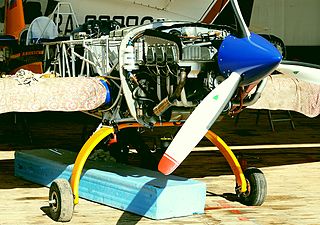Related Research Articles

The Continental XI-1430 Hyper engine was a liquid-cooled aircraft engine developed in the United States by a partnership between the US Army Air Corps and Continental Motors. It was the "official" result of the USAAC's hyper engine efforts that started in 1932, but never entered widespread production as it was not better than other available engines when it finally matured. In 1939, the I-1430-3 was designated as the engine to power the Curtiss XP-55, an extremely radical pusher-engine fighter design that would not reach production.
The Lycoming IO-720 engine is a large displacement, horizontally opposed, eight-cylinder aircraft engine featuring four cylinders per side, manufactured by Lycoming Engines.

The Continental O-240 engine is a four-cylinder, horizontally opposed, air-cooled aircraft engine that was developed in the late 1960s for use in light aircraft by Continental Motors, Inc. The first O-240 was certified on 7 July 1971.

The Continental O-470 engine is a family of carbureted and fuel-injected six-cylinder, horizontally opposed, air-cooled aircraft engines that was developed especially for use in light aircraft by Continental Motors. Engines designated "IO" are fuel-injected.

The Continental IO-550 engine is a large family of fuel injected six-cylinder, horizontally opposed, air-cooled aircraft engines that were developed for use in light aircraft by Teledyne Continental Motors. The first IO-550 was delivered in 1983 and the type remains in production.

The Lycoming IO-580 engine is a horizontally opposed, six-cylinder aircraft engine featuring three cylinders per side, manufactured by Lycoming Engines.

The Lycoming IO-390 engine is a horizontally opposed, four-cylinder aircraft engine, manufactured by Lycoming Engines.

The Lycoming O-480 is a family of six-cylinder, horizontally opposed fixed-wing aircraft engines of 479.6 cubic inch displacement, made by Lycoming Engines. The engine is a six-cylinder version of the four-cylinder Lycoming O-320.

The Lycoming TIO-541 engine is a turbocharged, fuel-injected, horizontally opposed, six-cylinder aircraft engine featuring three cylinders per side, manufactured by Lycoming Engines.
The Rotax 532 is a 48 kW (64 hp) two-stroke, two-cylinder, rotary valve engine, liquid-cooled, gear reduction-drive engine that was formerly manufactured by BRP-Rotax GmbH & Co. KG. It was designed for use on ultralight aircraft.
The Lycoming O-340 is a family of four-cylinder horizontally opposed, carburetor-equipped aircraft engines, that was manufactured by Lycoming Engines in the mid-1950s.
The Hirth F-30 is a horizontally opposed four-cylinder, two-stroke, carburetted aircraft engine, with optional fuel injection, designed for use on ultralight aircraft and homebuilts.
The JPX D-320 and D330 are a family of French twin-cylinder, horizontally opposed, two-stroke aircraft engines.

The KFM 107 is a two-cylinder, two-stroke, single ignition, horizontally opposed aircraft engine designed for ultralight aircraft and motor gliders.
The KFM 112M is a four-cylinder, four-stroke, dual ignition, horizontally opposed aircraft engine designed for ultralight aircraft and motor gliders.
The Nelson H-63, known in the US military designation system as the YO-65, is an American dual ignition, four-cylinder, horizontally opposed, two-stroke aircraft engine that was developed by the Nelson Engine Company for use in helicopters and light aircraft. The engine designation means horizontally opposed 63 cubic inch displacement.

The Menasco M-50 was an American four-cylinder horizontally-opposed aircraft engine.

The Verner VM 133 is a family of Czech two cylinder, horizontally opposed, four stroke aircraft engines, designed and built by Verner Motor of Šumperk.
The Franklin O-425 was an American air-cooled aircraft engine that first ran in the mid-1940s. The engine was of six-cylinder, horizontally-opposed layout and displaced 425 cu in (7 L). The power output was between 240 hp (179 kW) and 285 hp (213 kW) depending on variant. The O-405-13 (6V6-300-D16FT) of 1955 was a vertically mounted, turbocharged and fan cooled version for helicopters.
The Rotorway RW133 is a piston engine designed for use in helicopters and homebuilt aircraft.
References
- 1 2 3 4 5 6 7 8 Federal Aviation Administration (April 1959). "AIRCRAFT ENGINE SPECIFICATION, Revision 6" . Retrieved 2009-01-04.
- 1 2 3 4 5 6 7 8 Federal Aviation Administration (March 1959). "AIRCRAFT ENGINE SPECIFICATION, Revision 2" . Retrieved 2009-01-04.
- ↑ Murphy, Daryl (2006). "The Cessnas that got away". Archived from the original on 2009-02-27. Retrieved 2008-12-22.
- ↑ Collinge, Ken & Glidden S. Doman (2006). "Doman Helicopters: Unsung Innovations, Part 1" . Retrieved 2009-01-04.